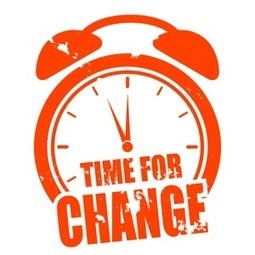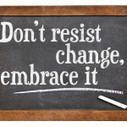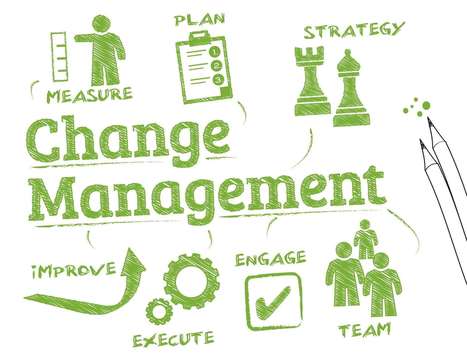 Your new post is loading...
 Your new post is loading...
Although breakthroughs have been made in explaining why people think and behave as they do, these insights have in general been applied to business only piecemeal and haven’t had a widespread effect. Recently, however, several companies have found that linking all of the major discoveries together in programs to improve performance has brought about startling changes in the behavior of employees—changes rooted in new mind-sets. Performance-improvement programs that apply all of these ideas in combination can be just as chaotic and hard to lead as those that don’t. But they have a stronger chance of effecting long-term changes in business practice and thus of sustaining better outcomes.
Via David Hain
The constant struggle to stay ahead of the competition means that all businesses must constantly change with the times in order to keep up with the competition, adapt to evolving customer demand and keep up with digital trends.
Often, new technology is seen as a solution to these issues, for instance the rise of contactless payment cards on the London Underground. This is an example of a company adapting to changing times by improving process and technology.
This is all well and good and in this case has been heralded as a great success, with usage growing month on month, but what about other companies who roll out a major change without focusing on the most important aspect of change – the people?
John Kotter’s book Leading Change (Harvard Business Review Press, 2012) reported that 70% of change initiatives in organizations fail. As technology and the global marketplace evolve, organizational change has shifted from a “nice to have” to a business necessity, forcing organizations to become more adept at transformational change management (a change in organizational strategy and processes designed to be organization-wide).
Yet, if Kotter is correct, 70% of organizations would continue to suffer failure when implementing change. Why is this so?
Old models perpetuate the feeling of negativity and disempower the staff, writes Polly Pascoe
I have been writing a series of articles on culture-enabled organizational transformation. Much of my philosophies on this subject are derived from learnings on the battlefield as a Navy SEAL, and in the boardroom as an entrepreneur. There are three phases to my transformation model, each with several components: building the change culture, preparing for the change battle, and winning the change fight. Once a company is well-prepared for change and high levels of trust and accountability have been woven into the fabric of the organization's culture, only then can they start preparing for the change battle. Behaviors and mindsets must adapt and a plan of attack developed and communicated. The first phase of winning the change fight is to empower the team and enlist as much participation as possible at all levels.
Via The Learning Factor
In any improvement process, managing the influence of change and the anti-change culture will be one of the most difficult tasks.
When people work in silos, different units and capabilities are pulled in when the time is right. Legal might hand off to marketing, or the user experience team is consulted only after design is completed. This approach won’t cut it in today’s mobile- and social-first digital world, in which everything has to be simple, seamless, and intuitive from the start. And it particularly doesn’t work when it comes to digital and technology initiatives. It’s hard, for instance, to develop a cohesive and unified digital vision when 68 percent of digital and tech spending occurs outside of IT budgets.
Building a working environment conducive to collaboration is key. Rather than encourage people to toil in isolation or only with their peer groups, modern working environments must allow for a cross section of specialists to be in close proximity to one another, even if that closeness is achieved only in cyberspace. When they learn how their teammates work, colleagues will develop the next imperative for a connected workforce: the ability to understand one another’s working language.
Via David Hain
Change champions tend to pay attention to the upside of their future vision and the downside of today’s status quo. For example, those who are passionate about customers are hyper-focused on building relationships for the long term. To them, resistors seem greedy or blind.
Conversely, resistors pay attention to the downside of the change and the upside of the current state. They see the risks. When change champions refuse to discuss an issue, resistors assume they are hopelessly naive or sinister actors trying to pull the wool over everyone’s eyes. To them, it can seem fiscally reckless to divert attention from the financial aspects of the business to softer issues such as customer experience. Which of them is right? “They both are,” says Jacobs. “But each is only half-right.”
In the worst-case scenario, “us versus them” thinking devolves into factions that compete but never really engage.
The solution is to reframe how we think about resistance. Rather than assuming critical thinkers are resistors, we would do better to treat them as guardians. Guardians see what needs to be protected, and the trust that can be destroyed by a broken promise or a shortcut. Who else will ask the hard questions?
Via David Hain
Change is changing - Riding the wave of change. Do companies no longer need change management processes. They need change leaders
Without work, we may drown in a sea of possibilities – or starve from no possibilities at all. The start of work means the end of freedom but also of doubt and wayward desires. “The accountant’s ten thousand possibilities have been reduced to an agreeable handful. She is a Business Unit Senior Manager, rather than a vaporous transient consciousness in an incidental universe.”
Life is no longer mysterious, sad, haunting, touching, confusing or melancholy: it is a practical stage of clear-eyed action when you’re at work.
Even when your workplace is not Utopia – work gives structure, meaning, and identity. Even when you don’t like your job. Like those many adults who spend their entire adult lives working at jobs chosen by their sixteen-year-old selves….
Via David Hain
1. Sorcery - Leaders attempt to change culture with a single magical approach. Whether it is “Lean manufacturing”, “Results based decision making”, “Customer focus” or “Process re-engineering”, leaders attempt to find the silver bullet of changing their culture. Whilst methods of improving quality or focusing on customers or improving efficiency help to give a focus to why we want to change culture, they in themselves, do not change culture. When a single focus approach is used, a short term improvement in culture is quickly overtaken by a return to the normal way of working.
Via Virtual Global Coaching
This is the sixth in a series of articles that discuss the 3P Change Equation approach to change in any organization – the foundation of my Fired Up & Focused keynote and workshops. Realizing a need for change and having a plan to stimulate change are very different. Making any type of change to the status quo is never easy – it’s even more difficult without a clear change management plan to help guide your organization through the disruption, chaos and unfamiliar territory that is brought on by change.
Via Virtual Global Coaching
What’s hard about change management for digital transformation projects? Rahul Gupta of Capgemini explains.
Via Virtual Global Coaching
|
Huh? What is change management?
It’s a question that those of us in the field get a lot. And having heard a few people try and answer the question, gee whiz it gets complicated.
Here’s the simple break down.
You know how people generally don’t like change?
And you know how businesses like to change things a lot?
Change management is the practice of helping people like the changes a lot more than they normally might.
Via David Hain
While it may seem like remaining employed after a company’s reorganization is reason for celebration, the reality is often not so rosy. A 2015 survey by research and training company Leadership IQ found that 74% of employees who kept their job after a corporate layoff said their productivity declined. Many report feelings of guilt, anxiety, and anger. Another 2016 study by the University of East Anglia in England found that even when companies are restructured without layoffs, restructuring has a mostly negative effect. If you’ve been through a “re-org” and still have a job, getting over those negative feelings and finding your way is important for your future success, says Dave Popple, president of Psynet Group, an employee assessment firm. “If you survived a reorg, it is because your company saw value in you and believe that you can help them move forward,” he says. So, if you’re having trouble reconciling your feelings and taking advantage of the new opportunities before you, here is a seven-step plan.
Via The Learning Factor
Given the rapid pace of change and the level of uncertainty and disruption in today’s world, one of the most important skill sets for managers to have is the ability to help employees embrace and respond effectively to change. Here are a few actions that will help you do so:
With Brexit underway, organisational leaders are said to be facing one of the most challenging periods in change leadership for over 30 years, but a recent 'State of Leadership & Change report’ found that while 90% of senior management expect organisational changes ahead of Brexit, 42% are not worried and 26% ‘not at all worried.’
The research also found that 75% said leaders are getting better at managing change, while 60% of respondents said their businesses had met their objectives for change in the past few years.
This is all the more surprising when traditionally it is commonly accepted that 70% of change initiatives fail to deliver results.
So why are leaders getting better at leading through change and what lessons can future leaders learn?
Change management strategies that fail often do so because of poor project management. Don't let that happen to you.
These days it’s less ‘business as usual’ and more ‘change as usual’ as our corporate environments (and world!) are in a constant state of flux. It means that change management itself is almost a dying trade being rapidly replaced by schools of thought around change leadership, agility and collaboration.
My opinion is even more organizations could benefit from an Agile approach if they implemented one step prior to working with Agile.
Since the concept took hold, big data has made big waves. The field of analytics has developed rapidly since the McKinsey Global Institute (MGI) released its landmark 2011 report, Big data: The next frontier for innovation, competition, and productivity. But much value remains on the table as organizations wrestle with issues of strategy and implementation. In this episode of the McKinsey Podcast, MGI partner Michael Chui and McKinsey senior partner Nicolaus Henke speak with McKinsey Publishing’s Simon London about the changing landscape for data and analytics, opportunities in industries from retail to healthcare, and implications for workers.
Via David Hain
How to implement successful organizational change management? How to lead organizational change? How to reinvent your business?
To achieve true transformational change, CEOs must have more than a strategic plan. To effect actual change, they need to understand how biases — their own, and their employees’ — can shape behaviors and decisions, and prevent them from achieving what they set out to achieve.
CEOs need to be especially aware of how the subtle forces of bias can operate in our subconscious and influence our choices. Let’s take a look at the two I see most often: loss aversion and conformity.
|



 Your new post is loading...
Your new post is loading...

































